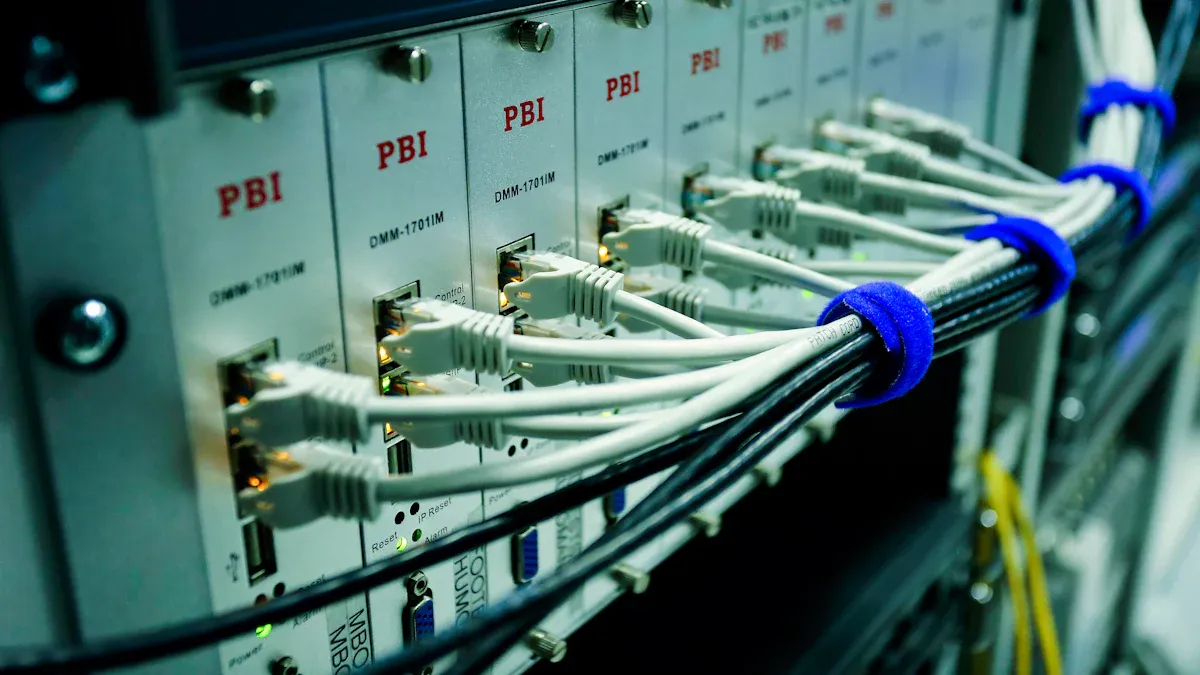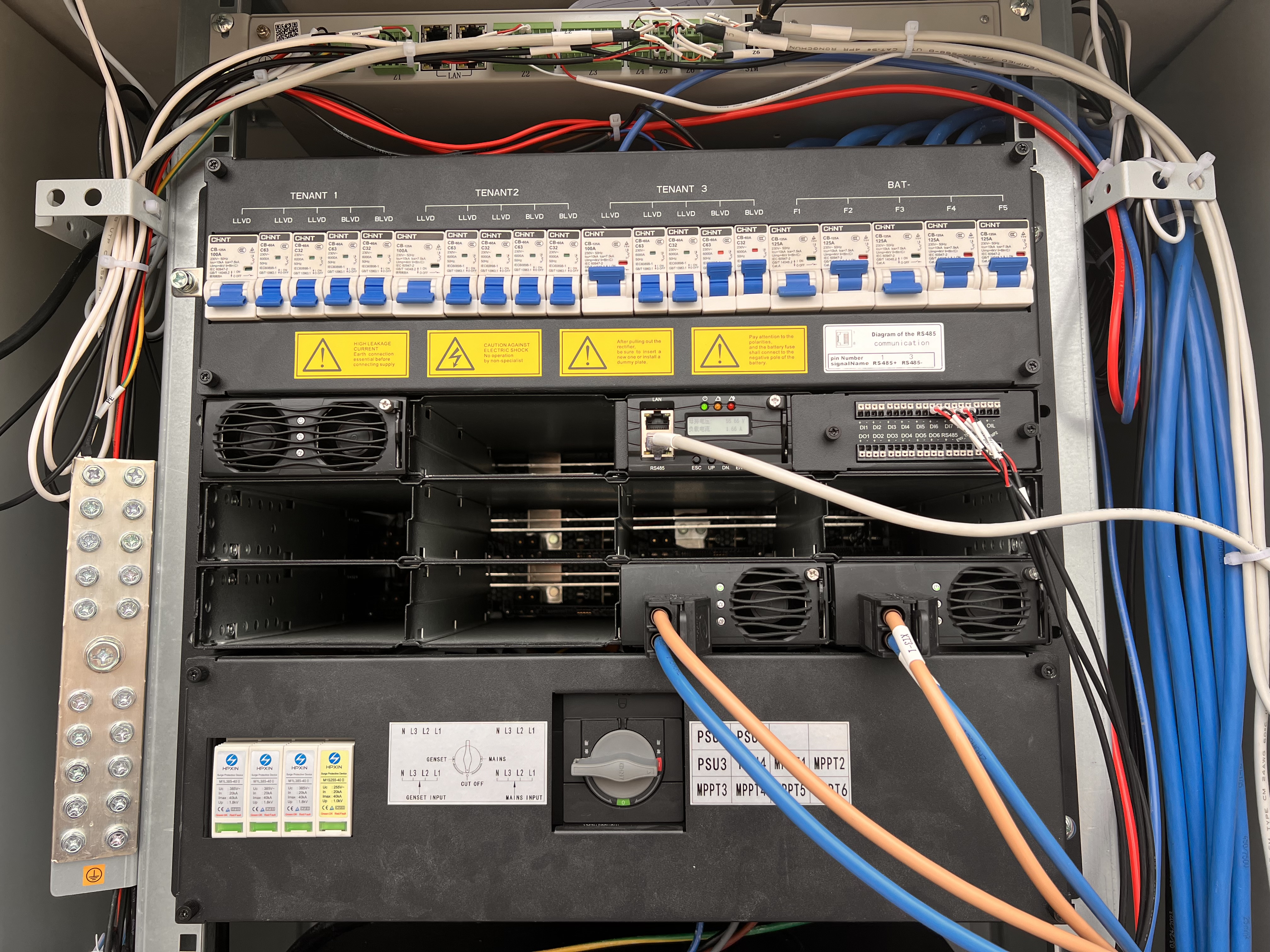What ESTEL Delta Rectifier Modules Are and How They Power Telecom Systems

Have you ever wondered how telecom systems stay powered and reliable around the clock? A delta rectifier module plays a key role in making this possible. This advanced device converts AC power into DC power, providing the stable energy telecom systems need to function. Without it, maintaining seamless communication networks would be nearly impossible. Its efficient design ensures consistent performance, even in demanding environments.
Key Takeaways
Delta rectifier modules change AC power into DC power. This gives telecom systems steady energy for smooth communication.
These modules work efficiently, reaching up to 98.5% energy savings. This lowers costs and helps the environment.
Their design makes upgrades and repairs simple. You can add power without stopping the whole system.
Smart monitoring tools check how they work in real time. This helps fix problems early and avoids system breaks.
Cleaning and checking them often is important. It keeps them working well for a long time.
What Are ESTEL Delta Rectifier Modules?
Definition and Purpose
You might wonder what makes a delta rectifier module so essential in modern systems. At its core, this device converts alternating current (AC) into direct current (DC). This transformation ensures that telecom systems receive a stable and uninterrupted power supply. Without this conversion, telecom equipment would face disruptions, leading to unreliable communication networks.
The primary purpose of a delta rectifier module is to deliver consistent DC power to critical systems. It supports telecom operations by maintaining the energy flow required for smooth functionality. These modules are designed to handle varying input voltages while ensuring output stability. This makes them indispensable in environments where reliability is non-negotiable.
Design and Functionality
The design of a delta rectifier module focuses on efficiency and durability. These modules are compact yet powerful, making them suitable for a wide range of applications. Their modular structure allows you to scale power capacity based on your system's needs. This flexibility ensures that you can adapt to changing requirements without overhauling the entire setup.
Functionality-wise, these rectifiers excel at converting AC to DC with minimal energy loss. They use advanced circuitry to regulate voltage and prevent fluctuations. This ensures that your telecom equipment operates within safe parameters. Additionally, their design includes features like overload protection and thermal management. These features enhance the module's lifespan and reliability.
Unique Features of Delta Rectifier Modules
What sets delta rectifier modules apart from other power solutions? First, their high efficiency ensures minimal energy wastage, which translates to cost savings for you. Second, their modular design allows for easy installation and maintenance. You can replace or upgrade individual modules without disrupting the entire system.
Another standout feature is their advanced monitoring capabilities. These modules often come with built-in systems that track performance metrics in real time. This helps you identify potential issues before they escalate. Additionally, their robust construction makes them suitable for harsh environments. Whether it's extreme temperatures or fluctuating power conditions, these rectifiers perform reliably.
Delta rectifier modules also integrate seamlessly with modern telecom infrastructure. Their compatibility with various systems ensures that you can deploy them across different applications. This versatility makes them a preferred choice for powering telecom networks, data centers, and other critical systems.
How Do Delta Rectifier Modules Power Telecom Systems?

AC to DC Power Conversion
Delta rectifier modules excel at converting alternating current (AC) into direct current (DC). This process is essential for telecom systems because most telecom equipment operates on DC power. Without this conversion, your telecom infrastructure would struggle to function efficiently.
These rectifiers achieve remarkable efficiency during the conversion process.
Delta Electronics' telecom power systems reach an efficiency rate of 98.5%.
They are widely implemented in 5G base stations across Asia.
Their advanced design reduces cooling costs by 22% compared to older models.
This high efficiency minimizes energy loss, ensuring that your telecom power supply remains cost-effective and environmentally friendly. By delivering reliable DC power, these modules support uninterrupted operations for critical telecom systems.
Stable Voltage for Telecom Equipment
Telecom equipment requires a stable voltage to perform optimally. Voltage fluctuations can damage sensitive components and disrupt communication networks. Delta rectifier modules prevent these issues by regulating the output voltage with precision.
You benefit from their advanced circuitry, which maintains consistent voltage levels even when input conditions vary. This stability protects your telecom equipment from overloads and ensures smooth functionality. Additionally, these rectifiers include built-in safeguards like overload protection and thermal management. These features enhance reliability and extend the lifespan of your telecom power supply.
Integration with Modern Telecom Infrastructure
Delta rectifier modules integrate seamlessly with modern telecom systems. Their modular design allows you to scale power capacity based on your needs. Whether you're powering a small base station or a large data center, these rectifiers adapt to your requirements without compromising performance.
Their compatibility with various telecom equipment makes deployment straightforward. You can install them across different applications, including base stations, data centers, and telecom cabinets. This versatility ensures that your telecom infrastructure remains future-proof and efficient.
Moreover, these rectifiers support advanced monitoring systems. You can track performance metrics in real time, enabling proactive maintenance and reducing downtime. This integration enhances the overall reliability of your telecom power supply, keeping your systems operational even in challenging conditions.
Key Features and Benefits of Delta Rectifier Modules
Wide Input Voltage Range
Delta rectifier modules stand out for their ability to handle a wide input voltage range. This feature ensures stable performance even when the incoming power supply fluctuates. You can rely on these rectifiers to maintain consistent output, which is crucial for telecom systems operating in diverse environments.
To better understand their capabilities, here’s a comparison between Delta rectifiers and conventional rectifiers:
Metric | Delta Rectifier | Conventional Rectifier |
|---|---|---|
Output Power | 10 kW | |
Output Voltage | 800 VDC | 800 VDC |
Input Voltage Range | 320V/400V/480V/530V (rms, line-to-line) | N/A |
Estimated Power Losses | Lower | Higher |
Efficiency | Higher | Lower |
Component Count | Fewer | More |
This table highlights how Delta rectifiers outperform conventional models in efficiency and reliability. Their ability to operate across a broad voltage range reduces the risk of downtime, ensuring your telecom systems remain operational.
High Power Density and Modular Design
Delta rectifier modules offer high power density, meaning they deliver significant power output while occupying minimal space. This compact design makes them ideal for telecom setups where space is limited. You can easily integrate these rectifiers into existing systems without requiring extensive modifications.
Their modular design adds another layer of flexibility. You can scale the power capacity by adding or replacing individual modules. This adaptability allows you to meet changing power demands without overhauling the entire system. The modular structure also simplifies maintenance, as you can address issues in specific modules without disrupting the entire operation.
Advanced Cooling and Monitoring Systems
Efficient cooling and advanced monitoring systems are critical for the long-term performance of Delta rectifier modules. These features ensure that the modules operate reliably, even under challenging conditions.
High Reliability: These rectifiers can function at temperatures as high as 175°C. Optimized chip design and enhanced heat resistance reduce the likelihood of failures.
High Efficiency: Miniaturized components, such as IGBT and diode chips, lower power losses during operation. This improvement enhances overall energy efficiency.
You can monitor performance metrics in real time, enabling proactive maintenance. This reduces the risk of unexpected failures and extends the lifespan of your telecom power systems. With these advanced systems, you gain peace of mind knowing your equipment is protected and operating at peak efficiency.
Benefits: Energy Efficiency, Reliability, and Scalability
When you choose a rectifier like the ESTEL Delta module, you gain access to three critical benefits: energy efficiency, reliability, and scalability. These advantages ensure your telecom systems operate at peak performance while minimizing costs and disruptions.
1. Energy Efficiency
Energy efficiency is one of the standout features of these rectifiers. They convert AC to DC power with minimal energy loss, achieving efficiency rates as high as 98.5%. This high efficiency reduces operational costs and lowers your environmental impact. By using less energy, you also generate less heat, which decreases cooling requirements and further improves overall system performance.
2. Reliability
Reliability is essential for telecom systems, and these rectifiers deliver it consistently. Their advanced design ensures stable voltage output, protecting your equipment from damage caused by fluctuations. Built-in safeguards, such as overload protection and thermal management, enhance their durability. You can trust these rectifiers to maintain uninterrupted power supply even in challenging conditions, ensuring the quality of your telecom services.
3. Scalability
Scalability is another key benefit. The modular design of these rectifiers allows you to expand or adjust your power capacity as your needs grow. You can add or replace individual modules without disrupting your system. This flexibility makes it easy to adapt to new technologies or increased demand, ensuring your telecom infrastructure remains future-proof.
Tip: Investing in a high-quality rectifier not only improves energy efficiency but also enhances the reliability and scalability of your telecom systems. This ensures long-term cost savings and operational stability.
By leveraging these benefits, you can optimize your telecom systems for performance, cost-effectiveness, and adaptability.
Applications of Delta Rectifier Modules in Telecom

Powering Base Stations
Delta rectifier modules play a vital role in powering base stations, which form the backbone of telecom networks. These stations require a consistent and reliable power supply to ensure uninterrupted communication. The rectifier converts AC power into DC power, which is essential for the operation of base station equipment.
You can rely on these rectifiers to handle fluctuating input voltages while maintaining stable output. This stability protects sensitive telecom equipment from damage and ensures high-quality service. Their modular design also allows you to scale power capacity as your network grows, making them a future-proof solution for expanding telecom infrastructure.
Supporting Data Centers
Data centers are critical for storing and processing vast amounts of information. They demand a dependable power source to maintain their operations. Delta rectifier modules provide the stable DC power required to keep servers and other equipment running efficiently.
These rectifiers excel in high-density environments like data centers. Their compact design saves space, while their advanced cooling systems prevent overheating. You can monitor their performance in real time, enabling proactive maintenance and reducing the risk of downtime. By ensuring a steady power supply, these rectifiers enhance the reliability and efficiency of your data center operations.
Enhancing Telecom Cabinets
Telecom cabinets house essential equipment that supports communication networks. These cabinets often operate in harsh environments, where temperature fluctuations and power instability can pose challenges. Delta rectifier modules address these issues by delivering consistent DC power and managing thermal conditions effectively.
Their robust construction ensures reliable performance even in extreme conditions. You can integrate these rectifiers seamlessly into telecom cabinets, optimizing space and improving system efficiency. Their advanced monitoring capabilities also allow you to track performance metrics, ensuring the long-term reliability of your telecom systems.
Note: Investing in high-quality rectifiers for your telecom applications not only improves system performance but also reduces operational costs over time.
Reducing Downtime in Telecom Systems
Downtime in telecom systems can disrupt communication, impact businesses, and frustrate users. You need reliable solutions to minimize these interruptions and maintain seamless operations. Delta rectifier modules are designed to tackle this challenge effectively.
How Delta Rectifier Modules Reduce Downtime
Real-Time Monitoring
These modules come equipped with advanced monitoring systems. You can track performance metrics like voltage, temperature, and power output in real time. This allows you to identify potential issues before they escalate into major problems.Built-In Safeguards
Overload protection, thermal management, and fault detection are standard features. These safeguards protect your telecom equipment from damage caused by power surges or overheating. By preventing equipment failures, you reduce the risk of unexpected downtime.Modular Design
The modular structure of Delta rectifiers makes maintenance quick and efficient. If one module fails, you can replace it without shutting down the entire system. This ensures continuous operation and minimizes service interruptions.
Tip: Regularly monitor your rectifier modules to catch minor issues early. Proactive maintenance can save you time and money in the long run.
Benefits of Reduced Downtime
Improved Service Quality: A stable power supply ensures uninterrupted communication for your customers.
Cost Savings: Avoiding downtime reduces repair costs and prevents revenue loss.
Enhanced Reputation: Reliable systems build trust with your clients and partners.
Delta rectifier modules provide the tools you need to keep your telecom systems running smoothly. By investing in these advanced solutions, you can minimize downtime and ensure consistent performance for your network.
Maintenance and Protection of Delta Rectifier Modules
Tips for Maintenance
Proper maintenance ensures the long-term performance of your Delta rectifier modules. Follow these tips to keep them in optimal condition:
Clean Regularly: Dust and debris can accumulate on the module's surface. Use a soft, dry cloth to clean it periodically.
Inspect Connections: Loose or corroded connections can disrupt power flow. Check and tighten all connections during routine inspections.
Monitor Temperature: Overheating can damage internal components. Ensure the cooling system works efficiently and keep the surrounding area well-ventilated.
Update Firmware: Manufacturers often release firmware updates to improve performance. Install these updates to ensure your module operates with the latest features.
Tip: Create a maintenance schedule to track cleaning, inspections, and updates. This helps you stay consistent and avoid missing critical tasks.
Common Issues and Solutions
Even with proper care, you may encounter issues with your rectifier modules. Here are some common problems and how to address them:
Overheating: Check the cooling system and ensure the airflow is unobstructed. Clean the vents and replace faulty fans if necessary.
Voltage Fluctuations: Inspect the input power source for inconsistencies. Use a voltage stabilizer if fluctuations persist.
Module Failure: If a module stops working, replace it immediately. The modular design allows you to swap out faulty units without disrupting the entire system.
Error Codes: Refer to the user manual to decode error messages. Most issues can be resolved by following the troubleshooting steps provided.
Note: Always consult the manufacturer’s guidelines before attempting repairs. This ensures you follow the correct procedures and avoid voiding warranties.
Importance of Regular Monitoring and Inspections
Regular monitoring and inspections are crucial for maintaining the reliability of your rectifier modules. By tracking performance metrics like voltage, temperature, and power output, you can identify potential issues early.
Routine inspections help you detect wear and tear before it leads to system failure. For example, spotting a loose connection during an inspection can prevent power disruptions. Monitoring systems with real-time alerts make this process even more efficient.
Reminder: Schedule inspections at least once a month. This proactive approach minimizes downtime and extends the lifespan of your equipment.
By following these practices, you can ensure your Delta rectifier modules remain efficient and reliable for years to come.
ESTEL Delta Rectifier Modules provide the dependable DC power your telecom systems need. Their advanced features, including modular design and energy efficiency, make them a perfect fit for modern telecom infrastructure. You can count on their high reliability to keep your systems running smoothly, even in challenging conditions. Regular maintenance ensures these modules perform at their best, reducing the risk of operational disruptions. By investing in these rectifiers, you enhance the stability and efficiency of your telecom network.
FAQ
What makes Delta rectifier modules suitable for telecom systems?
Delta rectifier modules provide stable DC power, ensuring uninterrupted telecom operations. Their modular design allows easy scalability, while advanced cooling and monitoring systems enhance reliability. These features make them ideal for telecom systems requiring consistent power distribution.
Can Delta rectifier modules handle diverse environments?
Yes, these modules operate efficiently across various conditions. Their robust construction and ability to manage a wide application range make them suitable for environments with fluctuating power or extreme temperatures.
How do you maintain Delta rectifier modules?
Regular cleaning, inspecting connections, and monitoring temperature ensure optimal performance. Updating firmware and scheduling routine inspections also help prevent issues and extend the module's lifespan.
Are Delta rectifier modules energy-efficient?
Yes, they achieve high energy efficiency by minimizing power loss during AC to DC conversion. This reduces operational costs and environmental impact, making them a cost-effective solution for telecom systems.
Why is modular design important in rectifier modules?
Modular design allows you to scale power capacity easily. You can replace or upgrade individual modules without disrupting the entire system, ensuring flexibility and minimizing downtime.
See Also
Understanding the ESTEL Power System for Telecom Cabinets
Ensuring Correct Voltage Levels in ESTEL Communication Cabinets
Calculating Power Systems and Battery Needs for Telecom Cabinets
Essential Features of Power Supply in Telecom Systems
Strategies for Maintaining Reliable Power in Telecom Cabinets
CALL US DIRECTLY
86-13752765943
3A-8, SHUIWAN 1979 SQUARE (PHASE II), NO.111, TAIZI ROAD,SHUIWAN COMMUNITY, ZHAOSHANG STREET, NANSHAN DISTRICT, SHENZHEN, GUANGDONG, CHINA


